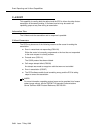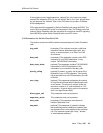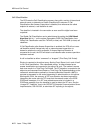
ASAI and Call Control
4-8 Issue 7 May 1998
Third Party Make Call and Supported
Call Types
The Third Party Make Call capability is used by the adjunct to request the ECS to
set up a call between two parties (calling endpoint and the called endpoint).
Five types of controlled calls are supported for the Third Party Make Call
capability:
1. Switch-Classified call
2. User-Classified call
3. Phantom Calls
4. Direct-agent call
5. Supervisor-assist call
1. Switch-Classified Call
A Switch-Classified call is the only call type used primarily by OCM applications
for Predictive Dialing when the destination is alerted first (using the
alert_order
parameter
). The administrator determines which calls are given to the agent
based on voice energy or the returned SIT or AMD tones from the call. All other
calls are dropped by the ECS and the classification reported to the adjunct (via
event reporting and/or call ended capabilities).
See Table 4-2 on page 4-13 for SIT and AMD tone definitions.
This is the only type of call placed with the alerted order and the service circuit
(classifier) options specified.
The originator of a Switch-Classified call must be a valid on-ECS extension
number associated with a split, hunt group, announcement, or VDN. The
originator cannot be a station extension. [However, in an EAS environment, a
VDN extension must be the originator for a predictive dialing application. See the
DEFINITY Enterprise Communications Server Call Vectoring/Expert Agent
Selection
(
EAS
)
Guide
, 555-230-521, for more information.]
The destination can be either a valid station extension [except Distributed
Communications System (DCS) or Uniform Dial Plan (UDP) extension], or an
off-ECS number. ISDN-PRI trunk types are the preferred facilities for these
outbound calls. It is recommended that trunks with answer supervision be used for
Switch-Classified outbound calls. Answer supervision from the network over the
trunk facility provides an accurate and timely indication when the far end answers.
Otherwise the ECS relies on the call classifier to do the call classification.
When a Switch-Classified call is launched over an ISDN/PRI trunk, such an
outgoing trunk must connect to the network as the “user” side of the PRI interface.


















